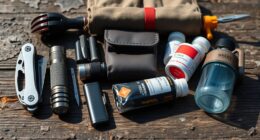When you're traversing in the wild, knowing how to use a map and compass is essential. Familiarize yourself with map symbols and topographic lines to assess terrain. Practice the shadow tip method with the sun for direction, and employ triangulation techniques using visible landmarks to pinpoint your location. It's vital to plan your route and keep an eye on your surroundings. Combine traditional tools with modern GPS technology for extra confidence. Always prioritize your safety by being prepared and aware. There's a lot more to mastering these skills that can make your outdoor experience even richer.
Key Takeaways
- Familiarize yourself with topographic maps and contour lines to understand terrain elevation and navigate effectively in the wild.
- Use a compass to orient your map; adjust for magnetic declination and verify your position with visible landmarks.
- Observe natural indicators like the sun's position or stars to determine cardinal directions and enhance your navigation skills.
- Practice triangulation techniques by taking bearings from known landmarks to pinpoint your exact location on the map.
- Regularly check weather conditions and ensure proper gear is prepared for safety and confidence during outdoor navigation.
Using a Map and Compass

When you're venturing into the wild, mastering the use of a map and compass is essential for navigation. Topographic maps reveal elevation changes and natural features through contour lines. You'll want to get familiar with these lines, as closely spaced ones indicate steep terrain while widely spaced lines show flatter ground. Be sure to reference the legend to understand symbols for streams, forests, and roads, and pay attention to the map's scale for accurate distance measurement.
To orient your map, align it with your surroundings using a compass. Position the direction of travel arrow toward the top of the map. Rotate the bezel until the orienting lines match the map's north-south grid lines, adjusting for magnetic declination. Once aligned, keep the map oriented and use visible landmarks to verify your position. Additionally, mastering traditional navigation fosters a deeper connection to the environment and enhances your overall outdoor experience, which is vital for self-reliance in remote areas.
As you navigate, set the compass to determine your bearing between two points. Follow the bearing by holding the compass level and turning your body until the magnetic needle aligns with the orienting arrow. This method keeps you on track, guiding you straight to your destination, even if it's not in sight. Practice these skills to enhance your confidence and accuracy in the wild.
Triangulation Techniques

Triangulation Techniques
Charting the wilderness can sometimes require more than just a map and compass; triangulation techniques can help pinpoint your location with greater accuracy. By taking bearings to two or more known landmarks, you can create a triangle that reveals your exact position.
Here's a quick overview of triangulation principles:
| Concept | Details |
|---|---|
| Definition | Using bearings from known landmarks to find an unknown location. |
| Intersection Point | Your location is where the lines from bearings intersect. |
| Landmark Identification | Requires visible, identifiable landmarks matching your map. |
| Visibility Requirements | Effective only when landmarks are visible. |
| Accuracy Dependence | Relies on precise bearing measurements and landmark identification. |
While triangulation is valuable for navigation, it's not foolproof. Poor visibility or complex terrain can hinder your ability to see landmarks clearly. Always verify that the landmarks you're using are on your map and easily recognizable. Be aware that GPS technology offers greater reliability, but knowing triangulation techniques can still be a lifesaver in the wild. In fact, many flaws exist in triangulation methods, making reliance on this technique unwise.
Natural Navigation Methods

When you're out in the wild, natural navigation methods can be your best friend. By observing the sun's movement, using stars for direction, and paying attention to nature's indicators, you can confidently find your way. Let's explore these techniques that connect you to the environment around you. Mastery of these methods can be life-saving during emergencies.
Sun's Movement Guidance
The sun's position serves as a reliable guide for outdoor wayfinding, helping you determine direction with ease. You can count on the sun to rise in the east and set in the west, giving you a basic orientation. At noon, the sun will be directly south in the northern hemisphere and north in the southern hemisphere.
To utilize the sun's movement, try the shadow tip method: find a straight stick, anchor it, and mark the tip of its shadow. After ten minutes, mark the new shadow tip and draw a line through both marks to establish an east-west line. Standing with the first mark (west) to your left and the second (east) to your right, you can easily determine north and south.
If it's afternoon, remember that the first mark indicates east, not west. Using your arm technique, face your direction, reach towards the sun, and hold that position for a few seconds. This helps you maintain your orientation as you focus on your surroundings instead of constantly checking a compass. With practice, wayfinding by the sun can become a second nature skill.
Additionally, understanding the sun's azimuth and altitude can enhance your ability to navigate effectively throughout the day.
Using Stars for Direction
Steering at night can seem intimidating, but the stars offer a reliable guide for those who know how to read them. In the Northern Hemisphere, finding Polaris, the North Star, is vital. You can locate it by following the line from the two stars at the end of the Big Dipper's bowl. Polaris remains nearly stationary in the sky, indicating true north. Celestial navigation involves using these fixed stars to determine your position and direction accurately.
To find south, look for Orion; when it's upright, the sword points directly south. If you're in the Southern Hemisphere, the Southern Cross (Crux) is your key to finding south—just extend the long axis of the cross. Understanding cardinal directions is straightforward. When you face Polaris, north is in front of you, south is behind, east is to your right, and west is on your left. The Milky Way also runs north to south, helping with orientation.
Practice recognizing these constellations and familiarize yourself with their seasonal appearances. Use clear skies and dark locations for the best visibility. Tools like star navigation apps can enhance your skills, but remember, combining this knowledge with other navigation methods is vital for effective wayfinding in the wild.
Observing Nature's Indicators
Finding your way through the wild isn't just about the stars; nature itself offers numerous indicators that can guide your way. Start by observing the sun's position. In the northern hemisphere, the sun rises in the east and sets in the west. You can use the shadow stick method: plant a stick in the ground, mark the shadow's tip, and wait for the shadow to move. The new tip marks east, helping you form an east-west line.
Landmarks also play a vital role. Mountains often run north to south, while rivers lead to larger bodies of water. Look for distinctive rock formations or tall trees to help maintain your direction. Additionally, understanding animal behaviors can provide insights into the location of food and water sources, enhancing your navigation strategy.
When it comes to plant life, remember that moss usually grows on the north side of trees, while trees themselves tend to be denser on the sunlit south side. Additionally, pay attention to wind patterns and animal migration paths, as they can indicate food and water sources.
Lastly, observe soil and terrain changes, and follow the flow of water downhill. All these natural indicators can effectively enhance your navigation skills in the wild.
Orienteering Skills

To navigate effectively, you'll need to master map reading techniques that help you interpret your surroundings accurately. Understanding compass usage basics is essential for maintaining your direction and ensuring you stay on course. Additionally, recognizing terrain features will enhance your ability to match the landscape with your map, making your journey smoother. Regularly checking the map to maintain situational awareness is crucial for efficient navigation.
Map Reading Techniques
Mastering map reading techniques is essential for successful orienteering, as it empowers you to maneuver through unfamiliar terrains with confidence. Start by orienting your map so that its features align with what you see around you. Use a compass to guarantee that north on the map matches magnetic north in reality. Keep your map oriented even when you change direction, adjusting as needed to maintain accuracy.
Familiarize yourself with standard map symbols, like blue for water and green for vegetation, and understand the scale, typically 1:10,000 or 1:15,000. This knowledge helps you estimate distances and recognize terrain features. Use the map legend to decode symbols effectively. Additionally, keep in mind that the scale represents the relationship between map size and actual area, which is crucial for determining distances.
When maneuvering, fold the map to focus on your immediate area, using your thumb to mark your current location. This technique helps you quickly identify where you are without scanning the entire map. Utilize handrails, such as trails or streams, to guide your route, breaking down complex paths into manageable segments. Identify catching features to avoid overshooting and use distinct attack points to guarantee accurate navigation. Regularly check off features to confirm your position and stay on course.
Compass Usage Basics
When you venture into the wild, understanding how to use a compass is essential for effective navigation. A compass consists of several key components:
| Component | Function | Description |
|---|---|---|
| Baseplate | Holds compass and aligns with map | Clear for visibility, straight edge |
| Compass Dial | Displays directions | Shows N, S, E, W, and degree markings |
| Magnetic Needle | Indicates north | Red end points north, white end south |
To orient the map, place the compass on it so the red needle aligns with the north-south gridlines. Rotate the map and compass together until the needle points to the top of the map. Once oriented, you can take a bearing by aligning the straight edge of the compass with your current location and destination. Rotate the bezel until the orienting lines match the map's gridlines, then read the bearing. The ability to establish direction is crucial for accurate navigation during your outdoor adventures.
When following a bearing, hold the compass with the direction of travel arrow pointing away from you. Rotate your body until the magnetic needle aligns with the orienting arrow, then follow the direction of travel arrow to stay on course. Regular checks will help you maintain your path.
Terrain Recognition Methods
Maneuvering through the wild requires more than just a compass; it hinges on your ability to recognize and interpret the terrain around you. Start by mastering map reading to identify the best routes between your controls, factoring in terrain difficulty and distance. Evaluate multiple route options, including handrails like paths or streams, to find the quickest way forward.
As you navigate, visualize the land's shape, paying attention to slopes and contour features. Recognizing key elements—paths, streams, or changes in vegetation—helps confirm your route. Use prominent features beyond your destination to avoid overshooting. Selecting clear attack points near controls enhances your accuracy. Additionally, ensure that your map must align with your running direction for effective navigation.
Handrails are critical for safe navigation, especially for beginners, so prioritize them when possible. For advanced navigation, incorporate less obvious line features like re-entrants. Remember to adjust your speed according to the navigational difficulty, breaking your journey into manageable sections.
Regularly check your map to align your mental picture with the terrain. If the landscape doesn't match your expectations, be ready to adjust your plan. Finally, employ pace counting in featureless areas to monitor your distance traveled effectively.
Route Planning Essentials

Route planning essentials are essential for a successful outdoor adventure, as they help you navigate unfamiliar terrain and guarantee your safety. Start by understanding topographic maps specific to your hiking area. Learn to interpret contour lines, symbols, and scales, and identify key features like trail markers, water sources, and prominent landmarks. Align the map with the ground using identifiable features or a compass to confirm accuracy.
Pre-trip planning is imperative. Study your chosen route on a map, noting key waypoints and trail junctions, while estimating distances and elevation changes to gauge difficulty. Check the weather forecast, as it can greatly impact trail conditions. Identify potential water sources and plan for safety and energy efficiency. Additionally, being familiar with topographic maps enhances your ability to navigate effectively in your hiking area.
When evaluating terrain, recognize challenging features to avoid, such as steep slopes or debris fields. Use natural navigation techniques like observing the sun's position and identifying linear features like ridges or streams. Continuous route monitoring keeps you on track. Regularly check your map and compass, and tick off features as you pass them. Stay observant of both immediate and distant terrain to relate it to your map, confirming you remain on course throughout your adventure.
Alternative Navigation Tools

Maneuvering the great outdoors today involves a mix of traditional tools and cutting-edge technology, giving you a variety of options to choose from. Maps and compasses remain essential for understanding terrain and direction. Familiarizing yourself with contour lines and landmarks can greatly enhance your navigation skills. When using a compass, verify it has a declination adjustment for accurate readings.
You can also rely on natural indicators, like the position of the sun or the growth pattern of moss, to guide you. Counting your pace helps estimate distances traveled, especially when visibility is limited.
On the modern side, handheld GPS units like the Garmin eTrex 20x offer precise location data and offline maps. GPS watches can record your route and help you navigate back to key locations. If you prefer using your smartphone, apps such as GaiaGPS allow for offline map access and waypoints without a cellular signal. GPS technology provides real-time data and emergency alert capabilities, making it a valuable resource for wilderness navigation.
Combining these traditional and modern tools can build your confidence. Use GPS to confirm your position while relying on maps and compasses for primary navigation. Always carry backups in case your modern devices fail, guaranteeing you stay oriented in the wild.
Safety Precautions

Before you head out into the wild, it's important to gear up for safety. Proper planning and preparation can save you from potential risks and guarantee a more enjoyable experience. Here are three significant safety precautions to keep in mind:
- Pre-Trip Planning: Check multiple weather sources for your destination to anticipate risks. Assess specific conditions like altitude and sun exposure. Inspect and test all essential gear, including safety equipment and guiding tools. Additionally, it's wise to review park rules to ensure you're aware of any specific regulations before you go.
- Wildlife Interaction: Maintain a safe distance from wildlife—at least 25 yards from most animals and 100 yards from predators. Avoid disturbing them; it's illegal to feed or frighten wildlife. Keep your dog on a leash and verify they're vaccinated.
- Guidance Safety: Stay alert to your surroundings and use a compass and map regularly. Confirm you know the time of sunset to avoid traveling in the dark. If you get lost, try to find a body of water to follow.
Practice and Improvement

Steering through the wilderness confidently requires consistent practice and improvement. Regularly honing your navigation skills boosts your confidence and prepares you for those remote adventures. Start by practicing in familiar areas before tackling the wild. Consider visiting orienteering courses in local parks or nature reserves to sharpen your skills.
Mastering map and compass techniques is essential. Learn to interpret topographic features, contour lines, and map symbols. Orient your map with a compass and determine bearings, adjusting for magnetic declination to maintain accuracy. Regularly practice using your compass to maintain a heading and prevent disorientation, even without a map. Additionally, understanding local geography aids in effective decision-making and route planning. Develop your map and compass reading skills by participating in orienteering courses or seeking guidance from experienced navigators. These hands-on experiences will deepen your understanding of using a compass and map in real-world situations. With consistent practice and a solid foundation in map and compass reading skills, you’ll be well-equipped to navigate confidently in any outdoor environment.
Incorporate natural navigation techniques, too. Familiarize yourself with finding your way by the sun, stars, and moon. Use shadow sticks to gauge direction based on sun movement and learn to recognize patterns in nature that indicate direction.
Terrain association and triangulation are also important. Match the landscape around you with map features and identify prominent landmarks. Use at least two visible landmarks for triangulation to pinpoint your location accurately. Regular practice of these techniques will refine your skills and guarantee you're well-prepared for any wilderness adventure.
Frequently Asked Questions
What Should I Do if My Compass Is Malfunctioning?
If your compass is malfunctioning, start by checking for metal or magnetic interference nearby. Make sure your GPS and location services are enabled. Test other compass apps to see if the issue is app-specific. If not, calibrate your compass using the Figure 8 pattern. Restart your device or app to troubleshoot. Finally, consider environmental factors like strong magnetic fields that might be affecting accuracy, and always keep your software updated.
How Can I Improve My Memory of Map Symbols?
Improving your memory of map symbols can be like adding color to a black-and-white photo. Start by incorporating symbols and images, using colors to differentiate them. Create visual associations with familiar concepts, and tell imaginative stories about the symbols. Organize the information into branches, focusing on keywords, and review regularly to reinforce your memory. Engage multiple senses to make the experience memorable, tapping into your brain's natural tendencies for better recall.
What Is the Best Type of Map for Beginners?
For beginners, the best type of map is one that offers clear landmarks and simple layouts. You'll want something that highlights key locations and provides a straightforward route to follow. Maps like those in games, such as Customs in Escape From Tarkov, are great because they combine loot opportunities with varying play styles. Start with these easier maps, and as you gain confidence, gradually explore more complex areas. You'll improve quickly!
Can I Use My Smartphone for Navigation in the Wild?
Yes, you can definitely use your smartphone for navigation. It gives you access to detailed maps and real-time updates, which can be super helpful. You can download maps for offline use, ensuring you won't get lost without cell service. Just remember to keep an eye on your battery life and consider carrying a backup charger. While it's convenient, it's also wise to stay aware of its limitations in rugged terrains.
How Do I Choose the Right Navigation Gear for My Trip?
When choosing the right navigation gear for your trip, consider your destination, terrain, and skill level. If you're venturing off-trail, opt for advanced tools like a GPS watch or an accurate compass. For on-trail journeys, a simple compass and map might suffice. Factor in the duration of your trip; longer excursions typically require multiple tools. Finally, set a budget that aligns with your needs, ensuring you have reliable gear without overspending.
Conclusion
Guiding through the wild can feel like dancing between chaos and clarity. With a map and compass in hand, you've got the tools to transform uncertainty into confident strides. Embrace the natural landscape, letting the sun guide you as you master orienteering skills. While technology offers convenience, don't overlook the power of traditional methods. By practicing and honing your techniques, you'll turn every venture into an adventure, balancing instinct with knowledge to find your way home.










